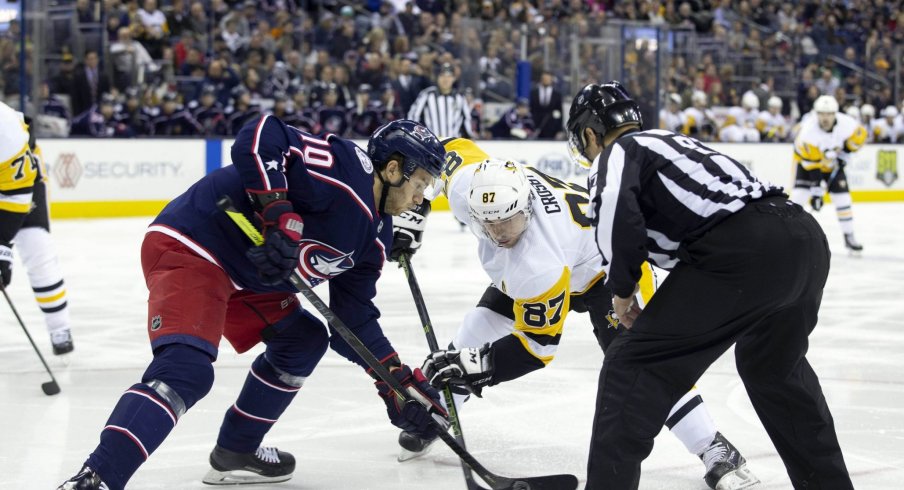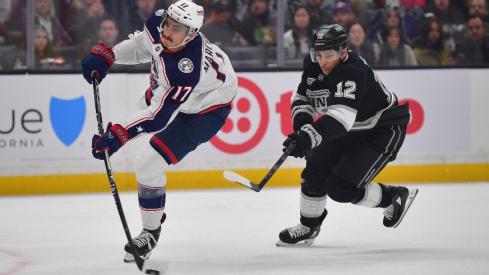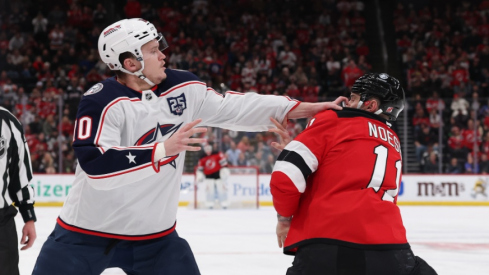The first three lines for the Columbus Blue Jackets seem to be solidifying.
Artemi Panarin, Pierre-Luc Dubois, and Cam Atkinson have been lethal all year on the first line.
Ryan Dzingel, Matt Duchene, and Oliver Bjorkstrand have emerged as a second line that's, for all intents and purposes, as fast and as skillful as a first line.
Nick Foligno, Boone Jenner, and Josh Anderson have solidified themselves as a third line that puts a premium on playing hard, forechecking intensely, and outworking their opponent on the ice.
The fourth line, however, is where it starts to get murky. A fourth line can make or break a team. It needs to be able to grind against an opponent's fourth line, but it also needs to be able to work against an opponent's quick, skillful first or second line if they're matched up on the ice. The fourth line is where minutes are earned for young players or veterans who may have lost a step.
Brandon Dubinsky, Riley Nash, Alexander Wennberg, Markus Hannikainen, Eric Robinson, and Lukas Sedlak have all seen minutes on the fourth line for Blue Jackets head coach John Tortorella this season. While recently it's been Dubinsky - Nash - Wennberg, all six of them want to make the lineup every night, and each has a legitimate claim towards a spot. Here's a look at what each forward brings to the table.
Brandon Dubinsky
| GP | G | A | PTS |
| 47 | 5 | 7 | 12 |
Dubinsky doesn't have the same mobility of years ago, but he does still bring some options to the ice. He's excellent in the face-off circle and is a reliable option on the penalty kill. A real grinder, his play style matches the usual grit of a fourth-liner, but can his body continue to deal with the repercussions of his aggressiveness? He'll be 33 in April. If the Blue Jackets make the playoffs, his experience could be quite useful for a young Columbus team.
Riley Nash
| GP | G | A | PTS |
| 65 | 1 | 7 | 8 |
There's no sugarcoating it: Riley Nash has been a disappointment in Columbus this year. After a 2017-18 campaign with Boston in which he put up 15-26-41, he has struggled to get his offensive game going with the Blue Jackets. His chemistry with his rotating linemates hasn't been great, and he often looks a step behind on the ice. Unbelievably, Nash's shooting percentage this year is a meager 1.6%, compared to his career average of 9.1%. It hasn't been a great first year in union blue for #20.
Alexander Wennberg
| GP | G | A | PTS |
| 63 | 2 | 21 | 23 |
Wennberg, without a doubt, is the most skillful player that John Tortorella has as an option for his fourth line. He can play center or on the wing, and is a viable option on both the penalty kill and power play. Wennberg is just two years removed from having the kind of season that made the Blue Jackets see him as a bonafide 1C, so the potential is there. The piece that's missing is offensive aggressiveness. Too often, he's looking pass-first instead of putting the puck on net. He'll need to take shooting opportunities more often.
Markus Hannikainen
| GP | G | A | PTS |
| 43 | 4 | 3 | 7 |
Hannikainen brings speed, grit, and aggressive forechecking, but not a whole not of finesse. He gets down in the dirty areas, and plays with a great motor. While he doesn't make a lot of mistakes, he doesn't offer much offensively. There also hasn't been any noticeable improvement from last season (3-3-6 in 33 games) to this season. He will be an RFA after the 2018-19 campaign.
Eric Robinson
| GP | G | A | PTS |
| 11 | 0 | 0 | 0 |
Robinson, to quote the Disney/Pixar classic Cars (2006), probably wakes up in the morning echoing the thoughts of our favorite red, plucky race car, Lightning McQueen: "Speed. I am speed...I'm faster than fast. Quicker than quick." Boy, does he have wheels. The end product is lacking though, as evidenced by his lack of points in 11 games. Robinson has a good hockey IQ, plays hard, and his speed allows him to get in great positions to score or make a key pass. He's like a mini Josh Anderson — but he might be even faster than Big Josh. He'll be an RFA at the end of the season, and I foresee no situation in which the Blue Jackets would not extend a qualifying offer to keep the young winger under their control.
Lukas Sedlak
| GP | G | A | PTS |
| 44 | 4 | 2 | 6 |
Sedlak is a no-nonsense center who has played on the wing at times this season. He's never been someone to put up a lot of points or get looks on the power play, as he's mostly defensively-minded. He's not great on face-offs but is an option on the penalty kill. Sedlak shows up, makes minimal mistakes, and gets his job done, with a typically meager offensive contribution. Like Hannikainen and Robinson, Sedlak will be an RFA after this season.
Here's how this writer believes it should shake out.
I hope to see Robinson - Dubinsky - Wennberg.
Without a doubt, the Blue Jackets' best lineup includes Alexander Wennberg in some capacity, so he should be in. His skill and vision with the puck is too much to ignore.
Dubinsky's experience alone is almost enough to get him a nod, but what pushes him into a spot is his skill in the face-off circle and background as a center. With Wennberg pushed to the wing, it's between Sedlak, Nash, and Dubinsky for the center spot, and Dubinsky is the best man for the job.
Nash has had a minimal impact this year, and he's been mostly invisible on the ice. No matter who he's been on a line with, he hasn't ever looked comfortable or threatening with the puck.
Sedlak is a known commodity: he's not flashy or particularly skillful with the puck, similar to Dubinsky. What sets Dubinsky apart from Sedlak, however, is experience and face-off skill.
Robinson's speed, potential, and willingness to play hard gets him the last spot. The goals and assists will come, and when he finally gets his first, the floodgates may open. Playing on a line with Wennberg will certainly afford him his fair share of opportunities to score thanks to #10's creativity with the puck.
This leaves Hannikainen on the outside looking in, but there's not really a case to make that he deserves a spot over Wennberg, Dubinsky, or Robinson. He's had some bright flashes, but he can't play center, nor is he an upgrade over Wennberg or Robinson.
Continuity, cohesion, and chemistry will be essential for whoever does end up on Tortorella's "final" fourth line. A good mix of skill, grit, and willingness to play the way that Tortorella wants are three key qualities that the three forwards chosen to play on the fourth line will need to exhibit.


